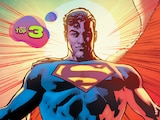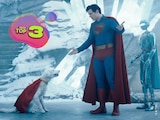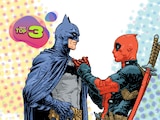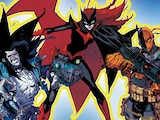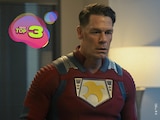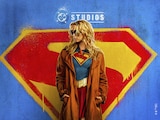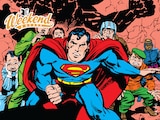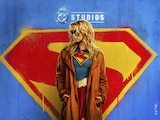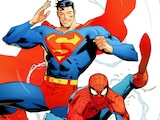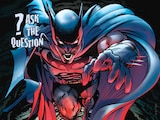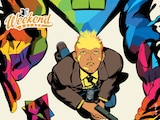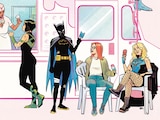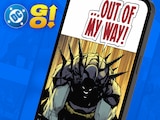SPOILER ALERT: The following interview contains spoilers from the first issue of Absolute Batman. We suggest reading it only after you’ve read the comic.
Don’t get it twisted: Absolute Batman is not another Batman origin story. This is Batman like you’ve never seen him before, a hero who cloaks himself in the fears and reality that inform our world the way Bill Finger and Bob Kane’s own New York inspired their Gotham City. But who better to give us the pitch than the creators themselves? With the first issue now in shops, we spoke to author Scott Snyder and artist Nick Dragotta about what makes the Absolute stories important and different, Batman’s true greatest nemesis, and the collected edition titling question on everyone’s minds.

I want to talk first about the ethos of the Absolute line. Is there a meaningful distinction between these titles, and the books we’ve seen come out of, for instance, Black Label, or 2009’s Earth One line?
Scott Snyder: That’s a great question. I mean, the idea with Absolute was to really approach the whole universe with one ethos. The beauty of something like Black Label is that every creator comes in and can take whatever approach they want to make that character resonate with them at that moment. You have Daniel Warren Johnson coming in and doing post-apocalyptic stories, you can have Dan Jurgens and other people coming in and doing Batman in the 1930s. So, there isn’t a unifying sensibility to it, beyond that every story is really individuated.
For us, with the Absolute universe, the idea was to share a mission statement. And the mission statement was we want these characters to remain true to core, but they’re happening now. We want the challenge for creators who are coming on to the Absolute universe to really look at the hero and think, “How can I make this hero more what they are?” if you pit them against the things in the world today? What things can you take away? What things can you adjust? What things can you give them? What things do you want to invert, to almost make them more heroic in the way that they’re heroic, if they’re up against things that are frightening to young people and to adults in today’s world?
Batman was the template for that. It wasn’t a book I thought I’d do. I didn’t know if I’d do any book in the Absolute universe. But it wound up being the example of how you might do one, that I used to pitch the Absolute universe to other creators.
With Batman, a story I’ve always wanted to do is, what if Batman, instead of being a part of the system and having the resources that Bruce Wayne does, came from a working-class background? What if he comes up in a world like today, where wealth is even more stratified? Where the generational billionaires are often the people that seem to be antagonistic to the rest of us. This is the way I pitched the Absolute universe.

Nick, did that inform your designs? How did that ethos manifest itself in the art of Absolute Batman?
Nick Dragotta: I mean, story dictates everything. From Scott’s initial idea, I was all in. When he told me his origin, I was like, “Yeah, I have to draw that.” And it felt kind of scary, and it felt really challenging. Just the fact that he called me to do this job—as an artist, these are the kind of gigs you dream about. To get one of the icons of American comics, and then given the reins creatively to reinvent him for today’s age… The proof is what you see in the book. We are absolutely engaged and inspired. But all the decisions go back to story first, and who this Bruce is.
One of the major differences from other alternate takes I’ve seen like the Earth One or All-Star initiatives, is that this universe is being presented to us, particularly in the All In Special, as something very much part of an ongoing narrative in the wider publishing line. Was making that connection important to setting up the Absolute universe?
SS: It’s extremely important. We’re going to give the Absolute universe and the main universe plenty of room to tell their stories before we really intersect them in any kind of way that would feel intrusive. But we wanted to show that the DC Universe now has these two approaches to superheroes. On the one hand, you have the classic, epic, great tapestry of legacy storytelling. It’s all elevated with jumping on points over in the main line. And then over here, you have this very unpredictable, chaotic, daring, strange and dangerous take on all these heroes in a collective space that’s next to that world. It’s hidden away. And so, we wanted to do something that’s one big meta-story, where ultimately these two worlds, these heroes, have to embrace each other to defeat the threat that is Darkseid, as he’s now becoming this kind of primal, final form state.
It’s a metaphor, in a lot of ways, for the situation in which comics finds itself today. You have all these naysayers, both in the comic community, but even more importantly, in pop culture saying, “Superheroes are over, comics are a dying form, they’ve had their peak.” And Darkseid, in this narrative, finds a way to elevate himself and evolve into the Omega of everything, where he’s a Galactus-level kind of Darkseid who makes sure that every story is told and finished. He’s a much scarier threat than he’s ever been. And the heroes have to embrace both the new, unfamiliar and daring, as well as the classic to be able to go up against him at all.
The story is something we really believe in as a company and as creators, from top to bottom. The initiative itself is that we have to tell stories. It’s about what we’re trying to say. So, them being connected is very, very important to us. It’s all part of one story, because it’s the thesis statement of the initiative that’s going to drive the line at DC for the next couple years.

Nick, I’m interested in the redesign you did for Black Mask. I was very shocked by the redesign of his mask, where you took that classic skull of death, and transformed it into this big, obsidian orb. I want to know what the psychology is behind that. What is this new Black Mask design meant to convey?
ND: I love the idea that it’s reflecting back at us. I don’t want to spoil anything, but we’ll learn a lot more about the Party Animals, the masks they wear and what they’re capable of in issue #2. The thing was to add mystery, and the fact that it reflects the reader, yourself, as well as the other characters, there’s something kind of creepy about that. And to have a skull come out of that really clean shape is just fun to play with. Plus, he’s kind of a fashionista on top of it, so he’s just that classic villain.
I’m kind of new to DC, right? It’s fun to put a spin on things and I really come out of a sci-fi bend, so I put a lot of that in. Scott’s original idea—and again, I don’t want to spoil it—these are more than masks. So, I’ll just say that much.
Hopefully, by now, people have read the first issue, because I really want to talk about THE BIG REVEAL. I get taking away Bruce’s money, that’s not what defines him. I get taking away his social network. He’s always been about resilience, and sometimes he works alone and that’s fine. But the big change that seems to take place here is…Bruce’s mom is ALIVE! And she LIVES with him! And they seem…kind of HAPPY? How can a Batman exist without that loneliness?
SS: That was one of the big challenges. “Does he need both his parents to die?” For us, it felt like he doesn’t have Alfred. At least yet. He has a good group of friends. And one of the things about growing up in a neighborhood around kids your age in a dense space like that is there’s a feeling of close-knit community. And it felt almost like the trauma that he suffers is so intense, and it’s something they’re all aware of, and it’s something they all experienced. They were all part of that class. You didn’t need both of the parents to be dead for Bruce to be haunted in that way. It teaches you the lesson of that world, without needing him to be completely devoid of parents.
It also felt like something we hadn’t seen, and it was so interesting to us. What do you do when you have this point of vulnerability? He’s this massive guy, and so strong and tough. And yet, his mother, who is politically active, is visible in a world where if anyone finds out who he is, they’ll go straight after her. So, that’s a big part of the story.

You’ve spoken in the past about how you wanted to make your ultimate statement on Batman by writing his first story, which you did with Zero Year, and his last story, which you did with Last Knight on Earth. Other than setting up a creative template for other teams to tackle on this Absolute line, what does this story represent in your overall work on Batman? What statement is this making about Batman himself?
SS: That’s a great question. The whole time I wrote Batman, it was very much about my fears. About myself, about the world as I saw it, for my kids—it was very, sort of, writing yourself into the book. I didn’t have a lot of time to sit back and think about the book, either. It was very instinctual.
This time around, I want to write not for what I’m afraid of, but for what my kids are afraid of. This is the world that my kids face, and I want him to make them brave in the face of the things that they’re challenged by. Looking at them, [the possibility of] a mass shooting is something that they deal with every day. My son, he’s 17 now, but in first grade, he went in the hallway one day to get a drink of water and they had an active shooter drill. It was just a drill, but he got caught in the hallway. And he wouldn’t go back to school all year without a thermos. He’d never use the bathroom at school.
So, this story, this Batman, if it represents anything for me in terms of the library of stuff that I’ve gotten to do on the character, it’s that I want this Batman to make my kids brave in the face of the things that they’re afraid of. He’s written as one of them. He’s inspired by them. I look at the world the way Alfred does. I mean, I’m not jaded. But Alfred is the character that I relate to where he comes in and he’s like, “Oh my god, what world have we left these kids? Look at everything falling apart! There’s so many hurdles for them, in all these ways.” And then, you have a kid, like our kids, who look out at the world and say, “We’re not going to accept that this is the best we can do. We’re going to change it. We’re going to be idealistic, even if things are entrenched and systemic, we’re going to be better than this.” Even if it means breaking stuff, or burning it down, to make better stuff on the other side.
That’s this Batman. It’s very different from the Bruce I wrote before.

Nick, Scott has spoken in the past about how the key to really nailing a comic book series is to write to your artist’s strengths and to ask them about the things they like to draw, and the things they don’t like to draw. I’m sure Scott must have asked you that. What did you tell him?
ND: He didn’t hit me like that! Gosh. I almost find, as an artist, you want to be pushed. I don’t want to talk about certain scenes, but in issue #2 there was a scene where I didn’t want to draw the fight scene there, but I’m really happy I did. It pushed me into a space that I normally wouldn’t go because it’s difficult to do.
Imagine that, one day, Absolute Batman’s run has ended, and DC wants to collect it in their oversized format. What is it called?
SS: [laughs] Absolute Absolute Batman.
YEAAAH! Ask your retailers now for Absolute Absolute Batman.
SS: I think it would be so cool if it was called that. I mean, we wanted to call it Batman AF, and there’s a joke about it in issue #2. We tried to get “Absolute Frontier” through the line, and we almost got it, until they were like, “Wait a minute. We can’t do that.”
Absolute Batman #1 by Scott Snyder, Nick Dragotta and Frank Martin is now available in print and as a digital comic book.

